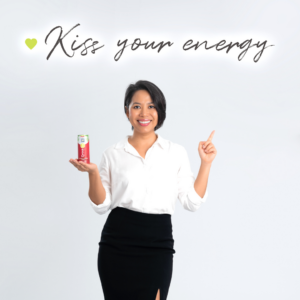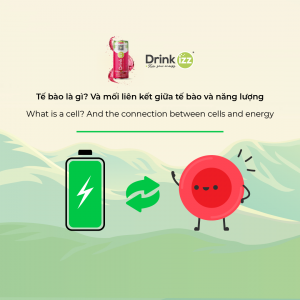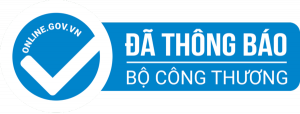What is energy and where does it come from? Do all macro and micronutrients provide the same type of energy? When you understand the source of energy, you will confidently choose and supplement sustainable, healthy energy sources for the body. This will bring you durable strength and fresh beauty every day.
1. What is a cell and the connection between cells and energy?
2. What are theine and caffeine? The impacts of theine and caffeine for your energy
What is energy?
Energy is the strength and vitality required for sustained physical or mental activity. (1)
Energy is used for functions inside the body such as nourishing, healing, and renewing cells. This is essential fuel for living; we need them to breathe, pump blood, move, grow, digest and all other aspects of our life. (2)
Energy comes from different dietary sources
- Calories
- Stimulating substances
- Antioxidants
- Micronutrients
- Water
Let Drinkizz explain more in-depth for you!
1. Calories (3)
Our bodies digest the food and drinks we consume by mixing them with fluids (acids and enzymes) in the stomach. When the stomach digests food:
- The carbohydrate (sugars and starches) in the food breaks down into another type of sugar, called glucose – fuel for the cells to produce energy.
- Fat from food is broken down into fatty acids, which can travel in the blood and is captured by hungry cells, and transformed into energy.
- Proteins are broken down into polypeptides, which are then broken down by many exopeptidases and dipeptidases to amino acids. If the body is not getting enough calories from other nutrients or from the fat stored in the body, protein is used for energy.
This energy source is measured in units of kilocalories (kcal) or kilojoules (kJ).
One kilocalorie (1 kcal) is equal to 4.18 kilojoules (4.18 kJ).
- Carbohydrate contains 3.75 kcal (16 kJ) per gram (for the purposes of food labeling this is rounded up to 4 kcal per gram)
- Protein contains 4 kcal (17 kJ) per gram
- Fat contains 9 kcal (37 kJ) per gram
2. Stimulating substances
Our bodies need a constant supply of energy, which it gets by breaking down a high-energy molecule called ATP.
In the process, it liberates adenosine. Neurons in your brain have receptors perfectly tailored to this molecule. When adenosine docks to these receptors, it activates a cascade of biochemical reactions that cause neurons to fire more sluggishly and slow the release of important brain-signaling molecules. (4)
In other words, you will be sleepy.
You will want the energy coming from theine or caffeine to feel more awake. Theine or caffeine acts as a central nervous system stimulant, helping to stay alert and focused by blocking the above mentioned important sleep-inducing molecules, adenosine. (5)
Theine and caffeine are chemically similar, but the difference between them is the dosage and the presence of L-theanine. (6)
- Caffeine can cause insomnia, nervousness and restlessness, stomach irritation, nausea and vomiting, increased heart rate and breathing, and other side effects if taken for a long time or in high doses. (7)
- Theine in tea is the result of oxidized polyphenols, which give off a stimulating effect. Theine is released much more slowly in the body but lasts for hours and thanks to the presence of L-theanine, it provides, at the same time, a feeling of relaxation. This is the reason why when drinking tea creates a different, softer feeling than coffee. (8)
*It is important not to confuse theine and theanine, as they are two completely different molecules. Theanine is an amino acid that reduces stress and relaxes the body. Theine is a methylxanthine and acts as a stimulant. (9)
3. Antioxidants
Antioxidants are artificial or natural substances that may prevent or delay some types of cell damage. (10)
Several antioxidants such as astaxanthin, catechin, quercetin, glutathione, and anthocyanin can improve the energy metabolism in the cell, which means mitochondria can produce more energy from the same amount of food more efficiently. (11)
4. Micronutrients
Micronutrients are one of the major groups of nutrients your body needs. They include vitamins and minerals.
Vitamins are necessary for energy production, immune function, and other functions. Meanwhile, minerals play an important role in growth, bone health, fluid balance, and several other processes. (12)
5. Water
Even though it contains no calorie content, water is the medium for most chemical reactions in the body, especially those metabolic reactions involved in energy production. The body uses water as a coolant, helping to regulate body temperature during exercise, fever, and in hot environments. (13)
Drinkizz O.N.E (Organic Natural Energy) provides energy in many ways!
O.N.E (Organic Natural Energy) drink contains organic sugar, which is transformed into glucose in your stomach for immediate energy.
Drinkizz O.N.E with 100% organic ingredients is a healthy organic natural source of energy for the body’s cells.
- Drinkizz O.N.E (Natural Organic Energy) contains organic sugar which is converted into glucose in your stomach for instant energy together with theine, antioxidants, and water.
- For your daily and long-term energy, it also contains theine from organic black tea, antioxidants from organic hibiscus and other organic plant-based ingredients, and silica from organic bamboo.
- Hydrating, refreshing, and energetic, Drinkizz is an excellent choice for instant and sustainable energy.
Drinkizz contains only 30kcal per 100ml, each 250ml can contain 75kcal, which is 3.75% of total calories needed based on the 2000kcal standard diet. This makes a difference because Drinkizz contains fewer calories and sugar than other synthetic chemical energy drinks. And it’s more nutritious, giving consumers a feeling of healthy energy filling and avoids empty calories and chemically flavored artificial sugars like liquid sugar from corn syrup.
Scientific links.
1: https://www.lexico.com/definition/energy
2: https://healthyeating.sfgate.com/five-reasons-body-needs-energy-4673.html
3: https://www.niddk.nih.gov/health-information/digestive-diseases/digestive-system-how-it-works
4: https://www.science14.com/how-does-caffeine-work/
5: https://www.sleepfoundation.org/nutrition/caffeine-and-sleep
6: https://www.ncbi.nlm.nih.gov/pmc/articles/PMC4787341/
7: https://www.healthline.com/nutrition/caffeine-side-effects
8: https://www.lautrethe.com/gb/blog/post/6-theine-caffeine.html
11: https://www.ncbi.nlm.nih.gov/pmc/articles/PMC6348409/
13: https://www.unm.edu/~lkravitz/Article%20folder/WaterUNM.html






